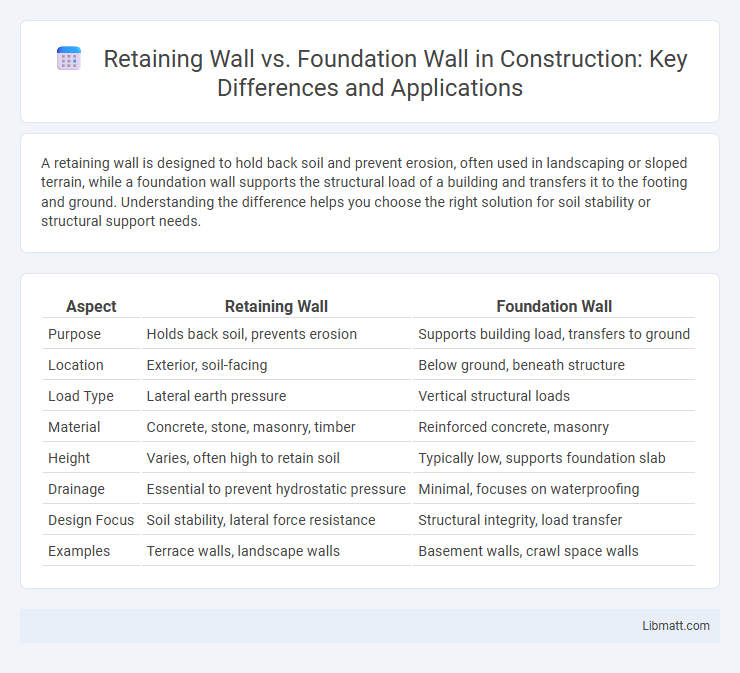A retaining wall is designed to hold back soil and prevent erosion, often used in landscaping or sloped terrain, while a foundation wall supports the structural load of a building and transfers it to the footing and ground. Understanding the difference helps you choose the right solution for soil stability or structural support needs.
Table of Comparison
| Aspect | Retaining Wall | Foundation Wall |
|---|---|---|
| Purpose | Holds back soil, prevents erosion | Supports building load, transfers to ground |
| Location | Exterior, soil-facing | Below ground, beneath structure |
| Load Type | Lateral earth pressure | Vertical structural loads |
| Material | Concrete, stone, masonry, timber | Reinforced concrete, masonry |
| Height | Varies, often high to retain soil | Typically low, supports foundation slab |
| Drainage | Essential to prevent hydrostatic pressure | Minimal, focuses on waterproofing |
| Design Focus | Soil stability, lateral force resistance | Structural integrity, load transfer |
| Examples | Terrace walls, landscape walls | Basement walls, crawl space walls |
Introduction to Retaining Walls and Foundation Walls
Retaining walls are structures designed to hold back soil and prevent erosion on sloped terrain, typically made from concrete, stone, or timber. Foundation walls provide structural support for buildings by transferring the load from the structure above to the ground below, ensuring stability and durability. Understanding the distinct purpose of your retaining wall versus your foundation wall is crucial for effective construction and soil management.
Purpose and Function of Retaining Walls
Retaining walls are engineered structures designed to hold back soil and prevent erosion on sloped terrain, creating level areas for landscaping or construction. Unlike foundation walls that support building loads, retaining walls primarily resist lateral earth pressure, ensuring soil stability. Their function is critical in managing soil displacement, water drainage, and preventing landslides on elevated ground.
Purpose and Function of Foundation Walls
Foundation walls provide critical support for the entire structure by transferring building loads to the footing and stabilizing the foundation against soil pressure and moisture. They create a durable barrier between the ground and the interior spaces, preventing water infiltration and insulating the building. Unlike retaining walls designed primarily to hold back soil, foundation walls serve as the main structural element anchoring and leveling the building.
Structural Differences Between Retaining and Foundation Walls
Retaining walls are primarily designed to hold back soil and resist lateral earth pressure, featuring reinforced concrete or masonry structures that withstand horizontal forces. Foundation walls serve as load-bearing elements transmitting building loads to the ground, constructed with thicker footings and materials engineered for vertical compression. Structural differences include retaining walls requiring greater lateral strength and drainage considerations, while foundation walls focus on vertical load support and stability.
Materials Used for Retaining Walls vs Foundation Walls
Retaining walls are typically constructed using materials such as poured concrete, concrete blocks, stone, or treated timber to withstand lateral earth pressure and provide soil support. Foundation walls, on the other hand, primarily use poured concrete or concrete block designed to bear building loads and distribute weight to the footing below. Choosing the right materials for your retaining or foundation wall ensures structural integrity and long-term durability.
Design Considerations for Retaining vs Foundation Walls
Retaining wall design considerations prioritize lateral earth pressure, drainage systems, and soil stability to prevent collapse or excessive movement. Foundation walls require load-bearing capacity, moisture control, and proper footing to support the structure above and distribute weight evenly. Understanding these distinct factors ensures your wall functions effectively in its intended role.
Drainage Requirements and Water Management
Retaining walls require well-designed drainage systems to prevent hydrostatic pressure buildup, often incorporating gravel backfill, weep holes, and drain pipes to channel water away efficiently. Foundation walls must manage water infiltration through waterproofing membranes and proper exterior drainage to protect the structural integrity of your building. Effective water management on both walls reduces soil erosion, prevents wall damage, and ensures long-term stability.
Cost Comparison: Retaining Wall vs Foundation Wall
Retaining walls typically cost between $15 to $60 per square foot, depending on materials and complexity, while foundation walls average $20 to $45 per square foot. Retaining walls require more labor and drainage considerations, potentially increasing expenses, whereas foundation walls often have standardized construction methods that can lower costs. Understanding these cost differences helps you budget effectively for structural support or landscaping projects.
Common Applications in Construction
Retaining walls are commonly used in landscaping and civil engineering projects to hold back soil on slopes, prevent erosion, and create level areas for patios, driveways, or roads. Foundation walls serve as structural supports for buildings, transferring the load from the structure above to the footing and ultimately the ground, ensuring stability and durability. Both walls are essential but serve distinct purposes: retaining walls manage earth pressure externally, while foundation walls provide internal structural support.
Choosing the Right Wall for Your Project
Choosing between a retaining wall and a foundation wall depends on your project's specific needs, such as soil retention versus structural support for a building. Retaining walls are designed to hold back soil and prevent erosion on slopes, while foundation walls provide stability and bear the load of a structure. Understanding the purpose and soil conditions of your site will help you select the right wall to ensure durability and safety.
Retaining wall vs Foundation wall Infographic

 libmatt.com
libmatt.com